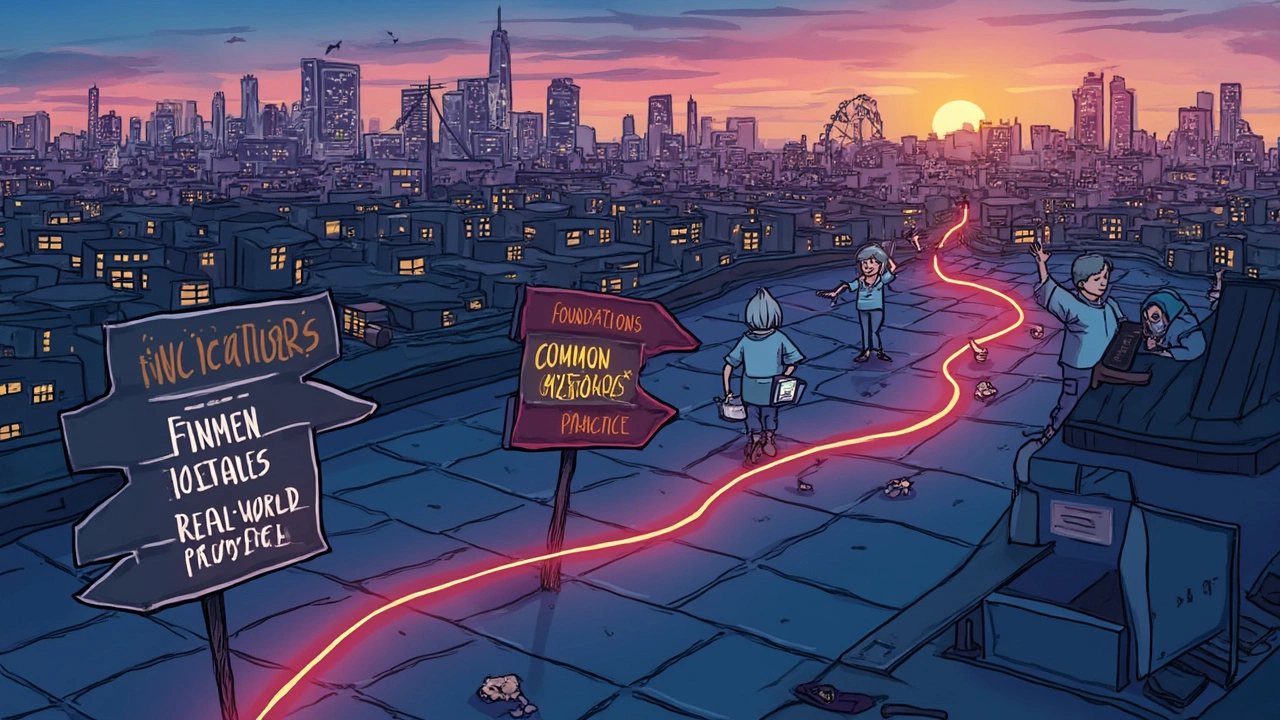Everybody wants a quick answer, but here’s the bold truth: nobody wakes up one morning with HTML, CSS, and JavaScript magically downloaded into their brain. You’ve got folks promising you’ll be a “web wizard in 30 days”—spoiler alert, that’s like saying you’ll dunk like LeBron after a month at the Y. The real timeline? That depends a lot on where you start and how you learn.
Before we toss around any numbers, you should know what you’re really signing up for. Learning these core web languages is more than just reading a few tutorials or copying code from YouTube. Real skill comes from messing up, troubleshooting, and actually making things work in the wild—stuff like building your own landing page, or tweaking someone else’s project until it feels like your own. So, it’s less about memorizing and more about practice and problem-solving.
- What 'Fully Learn' Actually Means
- Typical Learning Timelines
- Factors That Speed Up or Slow Down Progress
- Tips For Learning Faster
- What Comes After: Frameworks & Next Steps
What 'Fully Learn' Actually Means
So what do folks really mean when they say they want to "fully learn" HTML, CSS, and JavaScript? Spoiler: it’s not about memorizing every single tag or function—Google exists for a reason. Instead, it’s about being confident enough to build real websites from scratch, fix bugs that pop up out of nowhere, and maybe even make sites look sharp on a phone and a laptop without pulling your hair out.
Here’s what “fully learning” actually looks like in practice: you can take an idea, design how it should look, write the code, get it working, and polish it so it doesn’t scare away visitors. You get what all the main parts do and how they work together. Nobody expects you to code a billion-dollar app solo, but you shouldn't freeze if your code throws a weird error or if someone asks you to add a new feature.
To get even more practical, it's helpful to split up each language's essentials versus what usually comes later. Check this out:
| Skill | Essentials | Advanced |
|---|---|---|
| HTML | Headings, forms, tables, links, images | Accessibility, SEO improvements, semantic HTML |
| CSS | Selectors, color, layout (flexbox, grid), typography | Animations, preprocessors (Sass), responsive design tricks |
| JavaScript | Variables, loops, functions, DOM updates, events | APIs, ES6+, asynchronous code, build tools |
Knowing the essentials lets you actually build interactive pages, not just static posters. Advanced skills make you a real pro, but most jobs and freelance gigs care more about what you can make than some perfect theoretical knowledge.
If you want to check if you’re actually “done” with learning the basics, try building a project from scratch—something like a small portfolio site or a to-do app. If you can plan it, code it, debug it, and tweak the design until you’re happy, you’re already ahead of most people who quit when tutorials end.
Typical Learning Timelines
You’ve probably seen a ton of different estimates thrown around for how long it takes to get comfortable with HTML, CSS, and JavaScript. Some say weeks, others say years. Honestly, both can be true—but here’s a realistic look at what most beginners actually go through.
On average, if you spend about 1-2 hours a day working on the basics, you can expect timelines a bit like this:
| Skill | Basic Use | Feeling Comfortable | Building Real Stuff |
|---|---|---|---|
| HTML | 1-2 weeks | 3-4 weeks | 1 month |
| CSS | 2-3 weeks | 4-6 weeks | 1.5-2 months |
| JavaScript | 3-4 weeks | 2-3 months | 3-4 months |
The good news: HTML is a breeze to start with. You can build a basic page in just a couple of days and make it look decent in a couple of weeks. CSS will take longer because, frankly, getting a site to look right on every device can make your head spin at first. JavaScript? That’s where the real grind happens—it’s powerful, but there’s a lot to wrap your brain around.
Of course, these numbers can shift. If you go all in—for example, 20-30 hours a week like folks in bootcamps—you can expect everything to speed up nearly threefold. Some bootcamps say you’ll have job-ready skills in 3 months, but it comes at a relentless pace.
"You can learn basic web development in weeks, but you’ll spend years getting really good at it. The tech changes, the standards change, and you keep learning. That’s the fun part."
— Wes Bos, Full Stack Developer & Instructor
Consistency matters more than raw hours. Chipping away at a project every single day keeps things fresh and helps you remember what you learn. Trying to cram it all in on weekends just doesn’t stick the same way.
As you dive in, aim for real projects instead of just tutorials. Build a portfolio page, a to-do list app, or even copy the layout of your favorite site. That’s how these skills really start to click.

Factors That Speed Up or Slow Down Progress
If you’re trying to figure out how fast you’ll pick up learn HTML, CSS, and JavaScript, a few key things make a real difference. It's not just about racking up study hours; your style and your environment play big roles. Let’s break down the stuff that actually impacts your progress—and what usually throws people off track.
First, here’s a fast look at what pushes you forward or slows you down:
- Prior experience: If you’ve done any coding at all (even fiddling with Excel formulas), you’ll probably move a bit faster.
- Consistency: Regular, short sessions beat marathon cramming. Fifteen minutes a day is better than two hours once a week.
- Project-based learning: Building stuff you care about keeps you engaged—and the mistakes you make stick in your memory way longer.
- Community support: Asking questions in forums like Stack Overflow or joining local coding groups can un-stick you when tutorials fail.
- Distractions and burnout: Trying to learn while multitasking (Netflix on in the background, anyone?) will drag you down. Burnout from hustle culture is real, too. Take breaks.
Pacing yourself matters. The Mozilla Developer Network (MDN)—considered the gold standard for web docs—puts it bluntly:
“Rather than learning everything at once, work through small projects and increase difficulty as you gain comfort with each topic.” — Mozilla Developer Network
Here's some data that might surprise you. According to a 2023 Stack Overflow study, beginners who worked on a personal project within their first month were 34% more likely to stick with coding after six months compared to learners who just followed tutorials.
| Factor | Speeds Up | Slows Down |
|---|---|---|
| Prior experience | Yes | No experience at all |
| Consistent schedule | Daily/weekly practice | Random or rare sessions |
| Project-based learning | Active building | Passive tutorials only |
| Community or mentor | Strong support | Learning alone |
| Distractions | Focused sessions | Multitasking |
If you want to give yourself a push, set clear goals and make things you want to show off. Cut down on distractions and don’t be afraid to ask for help—most pros did the same thing when they got started. Your progress won’t be a straight line, but these factors are what actually move the needle.
Tips For Learning Faster
Pretty much everyone wants to learn HTML, CSS, and JavaScript as quickly as possible. Thing is, most people waste a ton of time doing things that don’t actually help. You don’t need another ten hours of video lectures that go over the same basics—what you need are smart strategies that push you out of tutorial mode and into building mode.
- Make stuff, break stuff, fix stuff. The fastest learners don’t just watch—they get their hands dirty. Pick a simple project, like a personal website, a to-do app, or even cloning a site you like. When you get stuck (and you will), look up answers, piece things together, and move on. Every bug you squash is a lesson you won’t forget.
- Get used to reading docs. Don’t panic—docs aren’t as scary as people think. Sites like MDN Web Docs are actually way better than random blogs or YouTube videos for finding the exact info you need on HTML elements, CSS properties, or JavaScript functions.
- Set clear, tiny goals. Timeboxing works wonders—tell yourself, "Today I’ll just learn styling with CSS Flexbox," or "I’ll play with JavaScript arrays." Small wins stack up way faster than trying to understand everything all at once.
- Ask for feedback early. Push your code to GitHub and share it with others. Join Discord servers or online communities like freeCodeCamp or Stack Overflow. Random internet strangers can spot errors and give advice you would've totally missed.
- Don’t memorize—use and repeat. There’s no prize for remembering 100 HTML tags by heart. Google is every developer’s sidekick. The more you look things up and use them in real projects, the faster they stick with you.
One study from Stack Overflow found that daily practice—even if it's just 20-30 minutes—beats cramming for hours once a week. So, shrug off perfectionism, poke around code, and let yourself mess up. Progress comes from building, not just reading or watching.

What Comes After: Frameworks & Next Steps
So, you’re feeling good about HTML, CSS, and JavaScript. Here’s the thing—modern web development rarely stops with the basics. Frameworks like React, Vue, and Angular are what companies and serious projects actually use. These tools aren’t just for tech giants; they speed up building complex apps, help manage code as things grow, and make teams way more productive.
But don’t dive into frameworks too fast. If you still struggle with event listeners or media queries, take more time with the basics. Frameworks assume you really know JavaScript inside and out. Once you’re comfortable, though, learning a framework becomes a superpower—it’s a total résumé boost, and it opens doors to better jobs and freelance gigs.
- React is the most popular by far. Over 42% of developers used React for their main projects in 2024, according to the annual Stack Overflow Developer Survey.
- Vue is easier to start with if you like straightforward, simple syntax.
- Angular is bigger and more complex, but used often by larger companies for business sites and apps.
Learning your first framework can take another couple of months if you study steadily—think a few hours a week, building sample projects along the way. Pro tip: join an online community or Discord server to get unstuck faster.
Here’s a quick look at what learning with and without frameworks can do for you:
| Approach | Speed to Build | Job Prospects | Community Support |
|---|---|---|---|
| Just HTML/CSS/JavaScript | Slower for big apps | Entry-level jobs | Massive |
| With Frameworks | Much faster | More options, higher pay | Huge (especially React) |
Once you nail your first framework, keep building real stuff—clones of popular apps, dashboards, or a portfolio that’s actually interactive. After that, you might want to look at backend stuff (Node.js, APIs) so you can call yourself “full stack.” But don’t get overwhelmed—take it one step at a time, and keep shipping code.
